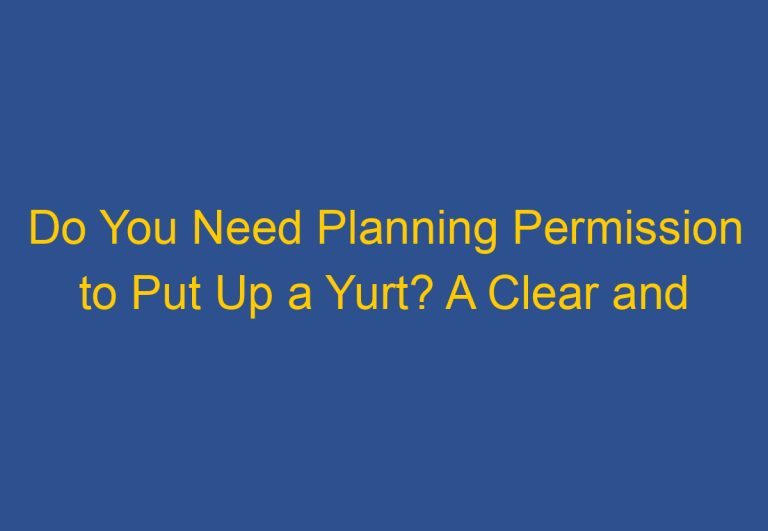Do You Need Planning Permission to Put a Yurt in Your Garden?
Putting a yurt in your garden can be an excellent way to create extra space for guests, a home office, or a relaxing retreat. However, before you go ahead and set up your yurt, it’s essential to understand whether you need planning permission. The rules and regulations around yurts and planning permission can be complex, so it’s important to do your research to ensure you don’t run into any legal issues.
In general, planning permission will be required for any permanent structure that is placed in a garden or on a piece of land. This includes yurts, which are considered to be temporary structures. However, if you plan to use your yurt for less than 28 days per year, you may not need planning permission. Additionally, if the yurt is smaller than 20 square meters, it may be considered a temporary structure and may not require planning permission.
It’s important to note that even if you don’t need planning permission, you may still need to comply with building regulations. These regulations ensure that structures are safe and meet certain standards. If you’re unsure about whether you need planning permission or building regulations approval, it’s always best to consult with your local planning authority.
Understanding Planning Permission for Yurts
Yurts are becoming increasingly popular as a way of enjoying nature without sacrificing comfort. However, before installing a yurt in your garden, it is important to understand the planning permission requirements. This section will provide an overview of the planning permission process for yurts and explain the different types of structures, permitted development rights, and exemptions.
Definition and Types of Structures
A yurt is a type of temporary structure that is typically made of canvas or other lightweight materials. It is designed to be portable and can be easily dismantled and moved to a new location. There are different types of yurts available, ranging from basic models to more luxurious versions that come equipped with amenities such as heating, lighting, and insulation.
Permitted Development Rights and Exemptions
In some cases, yurts may be exempt from planning permission requirements under permitted development rights. However, this will depend on the size and location of the yurt, as well as other factors such as the duration of the installation. The Planning Portal provides detailed information on permitted development rights and exemptions, and it is recommended that you consult this resource before installing a yurt in your garden.
Assessing Your Yurt Installation
Before installing a yurt in your garden, it is important to assess whether planning permission is required. This will depend on a number of factors, including the size of the yurt, the location of the installation, and the duration of the installation. It is also important to consider any potential impact on your neighbors and the surrounding environment. By carefully assessing these factors and consulting with local authorities, you can ensure that your yurt installation is in compliance with planning permission requirements.
In summary, installing a yurt in your garden can be a great way to enjoy nature and create a unique living space. However, it is important to understand the planning permission requirements and assess your installation carefully before proceeding. By following the guidelines provided by local authorities and consulting with the Planning Portal, you can ensure that your yurt installation is in compliance with planning permission regulations.
Complying With Local Regulations and Standards
When considering putting a yurt in your garden, it is important to comply with the local regulations and standards. This includes zoning laws, building codes, environmental considerations, and approval from the local planning authority.
Zoning Laws and Building Codes
Zoning laws and building codes vary depending on the location. It is important to check with the local planning authority to ensure that the yurt complies with the zoning laws and building codes in the area. This may include requirements for the foundation, boundary, and size of the yurt.
Environmental Considerations and Neighbors
It is important to consider the impact of the yurt on the environment and neighbors. This may include noise, light pollution, and the potential for damage to the environment. It is important to be considerate of neighbors and seek their approval before installing a yurt.
Applying for Planning Permission
In England, planning permission is required for most types of new development or changes to the use of land. This includes yurts. It is important to apply for planning permission from the local planning authority before installing a yurt. This may involve submitting plans and meeting with a planning officer to discuss the proposal. It is important to seek advice from the local planning authority to ensure that all conditions are met and approval is granted.
In summary, complying with local regulations and standards is crucial when considering putting a yurt in your garden. This includes checking zoning laws and building codes, considering the impact on the environment and neighbors, and applying for planning permission from the local planning authority. By following these steps, you can ensure that your yurt is installed safely and legally.
Frequently Asked Questions
What are the general requirements for obtaining planning permission for garden structures?
Before installing any garden structure, it is essential to check the local planning regulations. In general, planning permission is required for any permanent structure that exceeds certain size and height limits. However, temporary structures may be exempt from planning permission requirements.
Does the size of the yurt affect the need for planning permission?
The size of the yurt is a crucial factor in determining whether planning permission is required. In most cases, a yurt that exceeds certain size and height limits will require planning permission. However, smaller yurts may be exempt from planning permission requirements.
Are there any exceptions to planning rules for temporary structures like yurts?
Temporary structures like yurts may be exempt from planning permission requirements under certain conditions. For instance, yurts that are intended to be used for less than 28 days in a year may not require planning permission. However, it is essential to check the local planning regulations to determine whether any exceptions apply.
How does the intended use of a yurt influence planning permission requirements?
The intended use of a yurt is a significant factor in determining whether planning permission is required. If a yurt is intended to be used as a permanent dwelling, planning permission will almost certainly be required. However, if the yurt is intended to be used for other purposes, such as a garden office or a yoga studio, planning permission may not be required.
What regulations apply to structures on wheels in relation to planning permission?
Structures on wheels, such as caravans and mobile homes, are subject to different regulations than permanent structures. In general, planning permission is required for any caravan or mobile home that is intended to be used as a permanent dwelling. However, temporary structures on wheels may be exempt from planning permission requirements.
Can the presence of a yurt impact the land designation for planning purposes?
The presence of a yurt may impact the land designation for planning purposes. For instance, if a yurt is installed on agricultural land, it may be classified as a change of use, which may require planning permission. Similarly, if a yurt is installed in a conservation area or an area of outstanding natural beauty, additional planning restrictions may apply.












